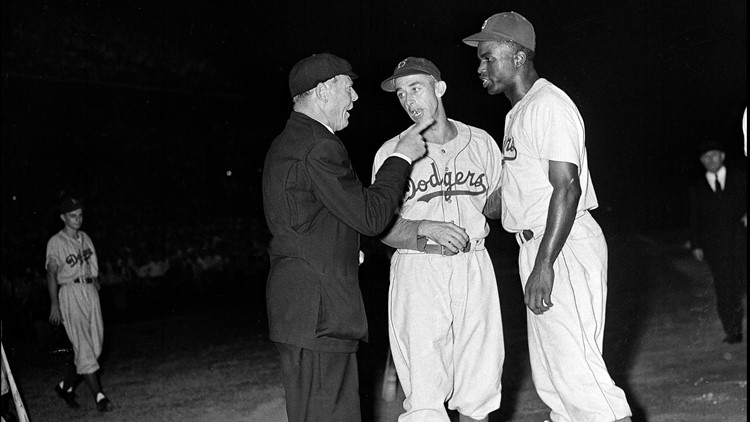MAINE, USA — The number 42 is being honored across Major League Baseball on Friday, with all players on all teams wearing the number on their jerseys in tribute to Jackie Robinson.
Robinson was the first Black player to play in the MLB in the modern era, paving the way for all who came after him. And it was a man from Maine who put Robinson in the lineup for the first time April 15, 1947.
That man was Clyde Sukeforth, who was born in Washington, Maine, and later moved to nearby Waldoboro. On April 15, 1947, Sukeforth was the Brooklyn Dodgers' interim manager.
He was originally hired by Dodgers general manager Branch Rickey in 1943 as a coach and scout. According to the National Baseball Hall of Fame, Rickey told The New York Times that Sukeforth, a former backup catcher, got the job because he came with “a box of about five dozen smelt, which he had caught through the ice along the coast near his home."
Sukeforth was the only other person in the room when Rickey told Robinson in 1946 that he planned to sign him to a contract, according to the National Baseball Hall of Fame.
Robinson went on to be named National League Rookie of the Year in 1947 and two years later he was the NL’s Most Valuable Player. He played in six World Series and was a member of Brooklyn’s world championship team in 1955.
In a 1972 letter, Robinson told Sukeforth, "While there had not been enough said of your significant contribution in the Rickey-Robinson experiment, I consider your role, next to Mr. Rickey's and my wife's -- yes, bigger than any other persons with whom I came in contact."
After calling Sukeforth "one of the true giants of this initial endeavor in baseball," Robinson went on to say, "Whenever I am in the Maine area, I'll find a way to get in touch with you."
The National Baseball Hall of Fame also said the following about Sukeforth's youth:
"Clyde Leroy Sukeforth was born on Nov. 30, 1901 to Pearle and Sarah Sukeforth. He grew up on a farm, and attended a one-room schoolhouse throughout high school. He and his sister, Hazel, would walk to school every morning – three and a half miles, each way – until Clyde transferred to the Colburn Classical Institute in 1916.
Although Washington was hundreds of miles away from the closest big league ballpark, baseball was an integral part of Sukeforth’s childhood.
“As a kid, we played baseball seven days a week, practice or games. In those days, football wasn’t too attractive, basketball didn’t mean much unless you were 7-feet-tall,” he told the Sport Collectors Digest. “When I was a kid I remember standing by the stagecoach, waiting for it to come through with the morning edition of the Boston Post, and the first thing I did was I opened it up to read about the Red Sox.”
After managing the dodgers, Sukeforth would become a coach and scout for the Pittsburgh Pirates, where he played an important role in drafting future Hall of Famer Roberto Clemente.
Sukeforth died at his home in Waldoboro in 2000. In addition to his love for baseball, he was a lifelong, avid outdoorsman.
In the words of NEWS CENTER Maine's Pat Callaghan, "More proof that there is a Maine connection to nearly every momentous story."



